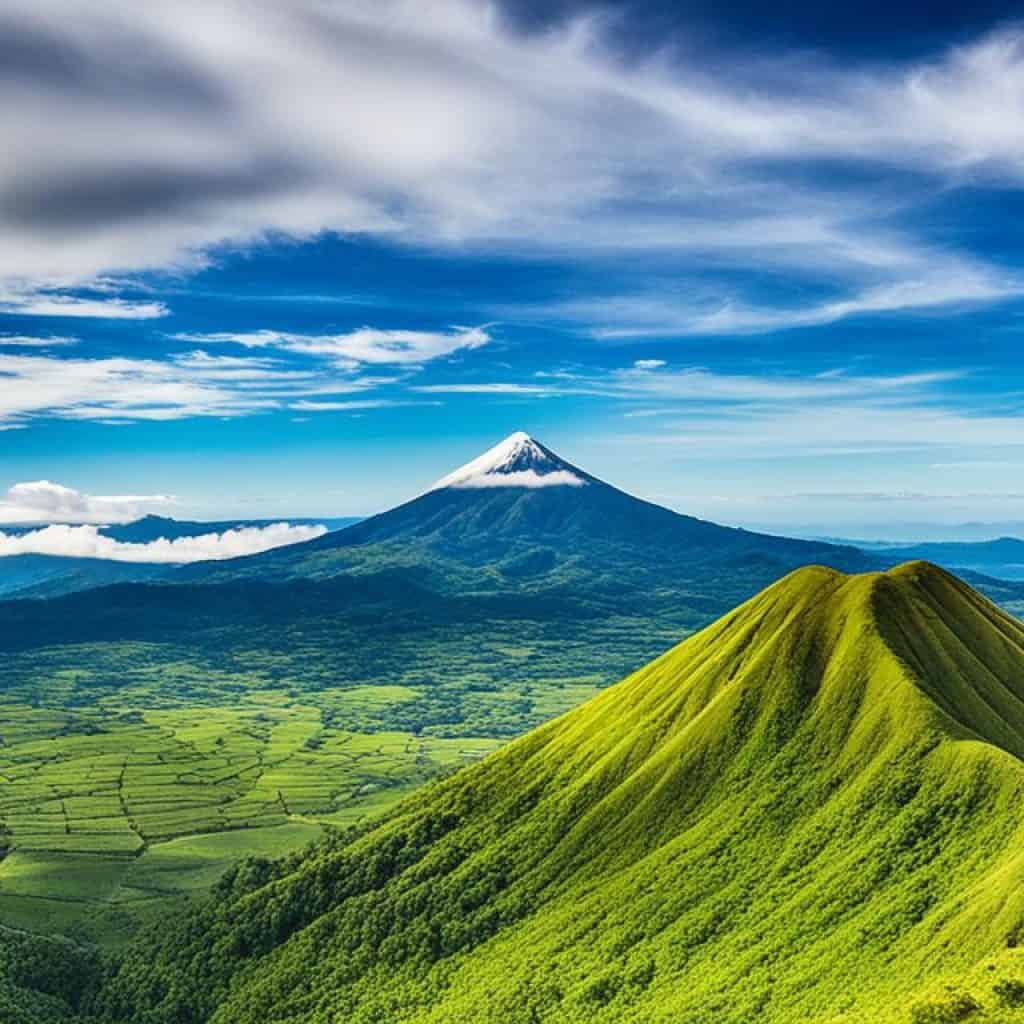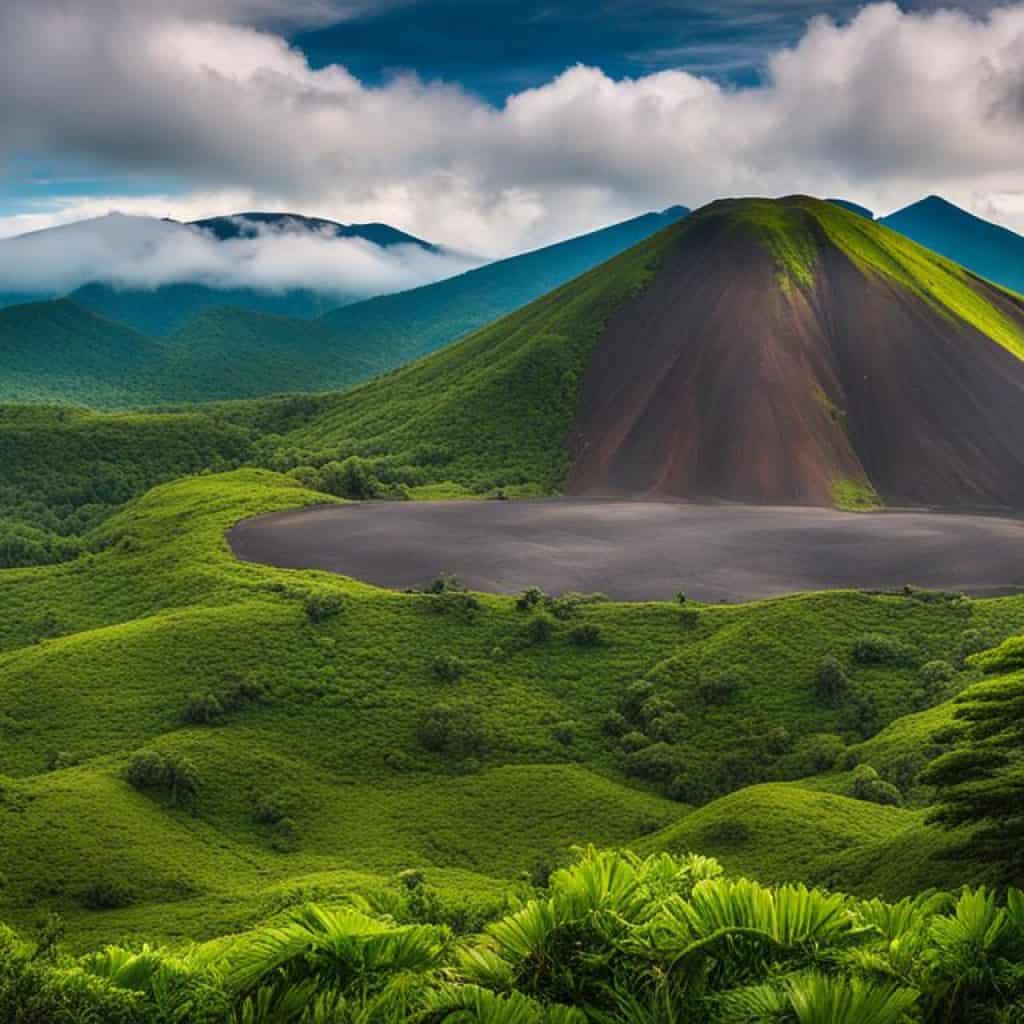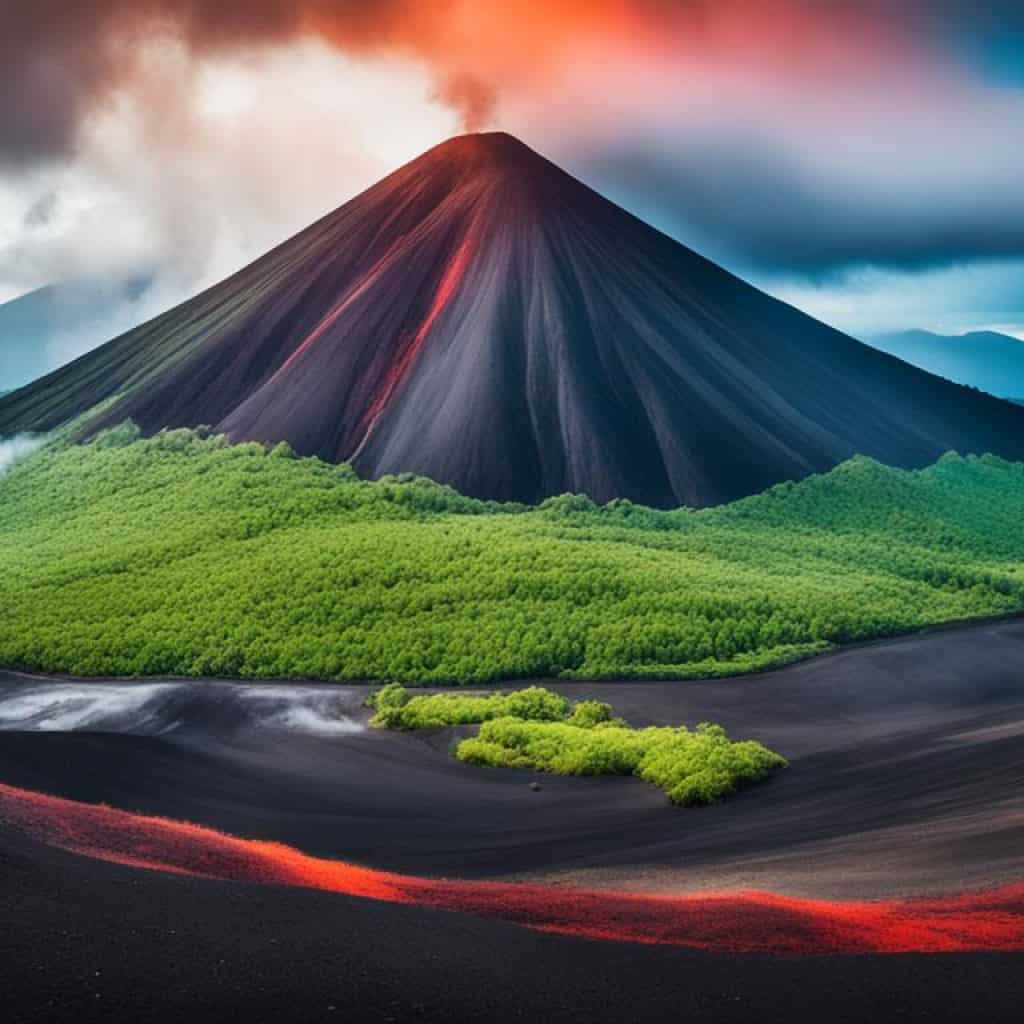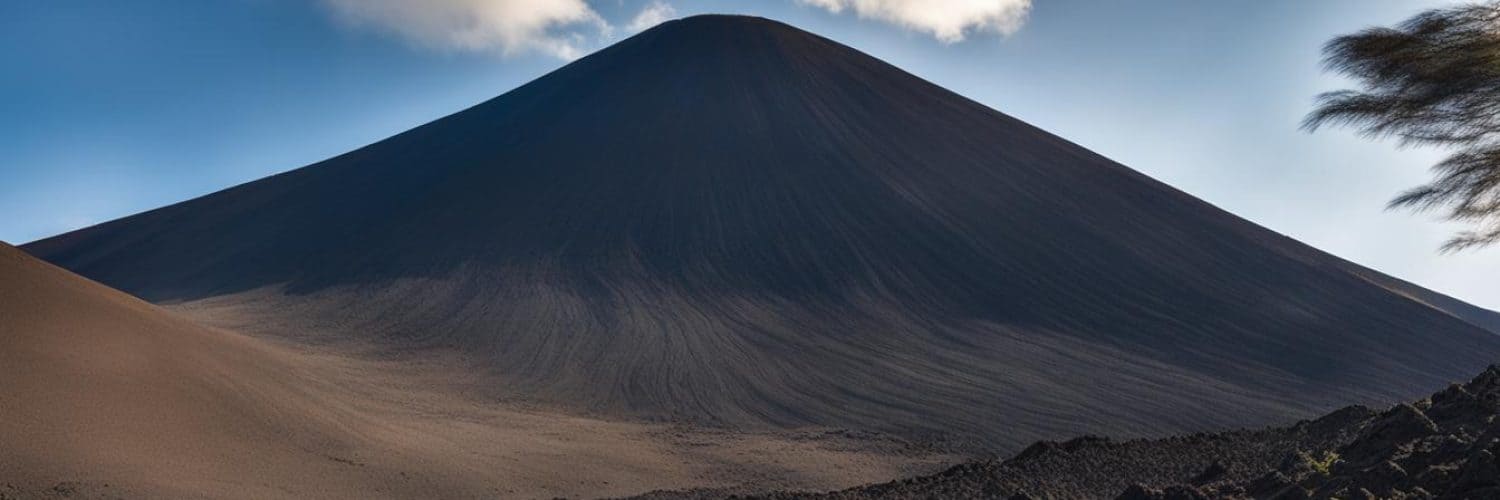Have you ever wondered what lies within the fiery heart of the Pacific Ring of Fire? Journey with us as we uncover the captivating world of the Cinder Cone Volcano in the Philippines. From its rich volcanic activity to its unique geological features shaped by volcanic eruptions, this natural wonder will leave you in awe of the immense power and beauty of nature.
Key Takeaways:
- The Cinder Cone Volcano in the Philippines is a geological wonder located in the Pacific Ring of Fire.
- It showcases unique volcanic activity and breathtaking geological features shaped by volcanic eruptions.
- The Philippines is home to other notable volcanoes like Mount Mayon and has experienced significant volcanic events like the Pinatubo eruption.
- Exploring the Cinder Cone Volcano offers the chance to witness stunning volcanic landforms while being aware of potential volcanic hazards.
The Landscape of Taal Volcano
Taal Volcano, located in Tagaytay, Luzon, offers breathtaking and picturesque views. It is characterized by the Taal Caldera, a large collapsed area formed during prehistoric eruptions, which is partially filled by Taal Lake. Within the lake lies Volcano Island, the active part of the volcano, consisting of numerous cones and craters. One notable cinder cone on Volcano Island is the Binintiang Malaki. At the center of Volcano Island is the crater lake, hosting Vulcan Point, a small rocky island. Although the volcano has not erupted since the seventies, occasional signs of unrest can still be observed.
| Key Features | Description |
|---|---|
| Taal Caldera | A large collapsed area formed during prehistoric eruptions. |
| Volcano Island | The active part of Taal Volcano, comprising cones and craters. |
| Binintiang Malaki | A notable cinder cone on Volcano Island. |
| Crater Lake | The center of Volcano Island, hosting Vulcan Point. |
Visitors to Taal Volcano are treated to picturesque and awe-inspiring views of the surrounding landscape. The Taal Caldera, a result of ancient volcanic activity, creates a dramatic backdrop as it encircles the partially filled Taal Lake. Volcano Island, the active part of Taal Volcano, showcases a diverse range of cones and craters, including the striking Binintiang Malaki cinder cone. At the heart of Volcano Island lies the mesmerizing crater lake, which is home to Vulcan Point, a unique rocky island.
Despite the calm in recent decades, occasional signs of unrest remind us of the volcanic activity that lies beneath the serene surface. Exploring Taal Volcano offers a captivating experience that combines the beauty of nature and the intrigue of a geological wonder.
Exploring Taal Volcano
Visiting Taal’s crater lake is an exciting adventure. Accessible by a boat trip across Taal Lake to Volcano Island, visitors can choose to hike or ride on horseback to reach the crater lake. The journey offers spectacular views of the surrounding landscape.
Alternatively, staying in Tagaytay provides great vistas of Taal Volcano, with its cool weather and numerous dining options to enhance the overall experience.
| Activities | Highlights |
|---|---|
| Boat Trip | Enjoy a scenic boat ride across Taal Lake |
| Hiking | Embark on a thrilling hike up to the crater lake |
| Horseback Riding | Experience the adventure of horseback riding to the crater lake |
| Great Vistas | Marvel at the stunning views of the landscape from various vantage points |
| Tagaytay | Stay in Tagaytay for a cool weather and picturesque views of Taal Volcano |
| Dining Options | Indulge in a variety of dining choices in Tagaytay |
The Beauty of Tagaytay Ridge
Tagaytay Ridge, known for its breathtaking views, offers a stunning panorama of Taal Volcano. Situated in the Philippines, this ridge provides visitors with a mesmerizing sight of Taal Volcano, a prominent and active volcano in the region. The scenic beauty of Tagaytay Ridge attracts tourists from all over the world, seeking to experience its awe-inspiring landscapes and natural wonders.
Amidst the captivating views, Tagaytay Ridge is home to posh resorts that cater to the discerning traveler. These luxurious establishments offer world-class amenities and services, ensuring a comfortable and indulgent stay for guests. From elegant accommodations to exquisite dining options, visitors can enjoy a lavish experience amidst the breathtaking backdrop of Taal Volcano.
However, it is important to note that the scenic beauty of Tagaytay Ridge stands in contrast to the presence of impoverished communities in the surrounding area. While visitors indulge in the opulence of the resorts, it is crucial to recognize the socio-economic disparities within the region. Initiatives aimed at supporting and uplifting these communities are essential for fostering a more equitable and inclusive environment.

Appreciating the beauty of Tagaytay Ridge and its panoramic views of Taal Volcano is undoubtedly a remarkable experience. It is a reminder of the diverse landscapes and natural wonders that the Philippines has to offer. By embracing responsible tourism practices and supporting local communities, visitors can contribute to the preservation and sustainability of this remarkable destination.
The Unique Geological Features of Cinder Cone Volcanoes
Cinder cone volcanoes are remarkable volcanic landforms with distinct characteristics. These cones are shaped by the powerful forces of volcanic eruptions, resulting in their unique features. Built from lava fragments and other volcanic materials expelled into the air during eruptions, these cones take the form of circular structures.
The formation process begins with the eruption, where molten lava is ejected from a volcanic vent. As the lava fragments cool down rapidly in the air, they solidify into small pieces called cinders. These cinders then accumulate and settle around the vent, forming the circular cone shape that we associate with cinder cone volcanoes.
The circular cones of cinder cone volcanoes are a testament to the intense volcanic activity that created them. The forces at work during eruptions shape the landscapes, leaving behind these visually striking landforms. Their unique features make cinder cone volcanoes a fascinating subject of study for geologists and an awe-inspiring sight for visitors.
“Cinder cone volcanoes exhibit remarkable geological features created by volcanic eruptions, showcasing the raw power of nature.”
Taal Volcano – A Prime Example of a Cinder Cone Volcano
Taal Volcano showcases the characteristics of a classic cinder cone volcano. Situated in the Philippines, this majestic volcano boasts a main crater lake, known for its mesmerizing beauty and historical significance. Within the sprawling caldera of Taal Volcano, lies an island called Vulcan Point, creating a captivating setting that draws visitors from all over the world. The nested lake islands within the caldera add to the allure, revealing the rich geological history of this remarkable natural formation.
The main crater lake of Taal Volcano is a stunning feature that accentuates its picturesque landscape. Surrounded by towering volcanic walls, the lake offers a tranquil and serene ambiance, providing the perfect backdrop for unforgettable adventures. The presence of Vulcan Point, an island within the lake, further enhances the uniqueness of this volcanic wonder. Its rocky terrain creates an intriguing contrast against the backdrop of the serene waters, attracting the attention of photographers and nature enthusiasts alike.
Witness the breathtaking beauty of Taal Volcano’s main crater lake, with its captivating island, Vulcan Point, nestled within. The combination of the tranquil waters and the rugged volcanic landscape creates a truly awe-inspiring sight.
As a cinder cone volcano, Taal has a fascinating history of eruptions, some of which have been carefully documented over the years. These historical eruptions serve as important reminders of the volatility and power that lie deep within the Earth’s core. Taal Volcano’s influence on the surrounding region is undeniable, leaving an indelible mark on the landscape and the people who call this area home.
Exploring Taal Volcano is an opportunity to delve into the geological wonders that have shaped the Philippines. From the main crater lake to the nested lake islands and the historical eruptions, every aspect of Taal Volcano tells a story of natural forces that have shaped the world we inhabit. Whether you’re a nature enthusiast, an adventure seeker, or a history lover, Taal Volcano promises an unforgettable experience that will leave you in awe of the Earth’s raw power and beauty.
Cinder Cone Volcanoes in the Philippines
The Philippines is home to several fascinating cinder cone volcanoes, showcasing the country’s volcanic activity and breathtaking natural wonders. One notable example is Mount Mayon, known for its symmetrical cone shape and majestic presence. Rising above the surrounding landscape, Mount Mayon stands as a testament to the powerful forces of nature.
Another remarkable feature of cinder cone volcanoes in the Philippines is the presence of cinder cone-shaped crater lakes. Taal Volcano, for instance, boasts a picturesque crater lake with its own unique charm. These cinder cone-shaped crater lakes add to the allure of these volcanic formations, creating a captivating landscape for visitors to explore.
However, it is essential to note that cinder cone volcanoes in the Philippines also have a history of dangerous eruptions. While their beauty may be enticing, it is crucial to approach these volcanoes with caution and respect. The volcanic hazards associated with these eruptions make them potentially hazardous, emphasizing the importance of responsible exploration and adherence to safety guidelines.

| Volcano | Location | Symmetry | Crater Lake |
|---|---|---|---|
| Mount Mayon | Albay Province | Highly symmetrical | No cinder cone-shaped crater lake |
| Taal Volcano | Calabarzon | Moderately symmetrical | Cinder cone-shaped crater lake |
| Mount Bulusan | Sorsogon | Asymmetrical | No cinder cone-shaped crater lake |
Notable Cinder Cone Volcanoes in the Philippines:
- Mount Mayon – Located in Albay Province, Mount Mayon is known for its iconic symmetrical cone and frequent volcanic activity.
- Taal Volcano – Situated in Calabarzon, Taal Volcano showcases a moderately symmetrical cone and a stunning cinder cone-shaped crater lake.
- Mount Bulusan – Found in Sorsogon, Mount Bulusan exhibits an asymmetrical shape and is recognized for its volcanic activity.
Exploring these remarkable cinder cone volcanoes in the Philippines offers a glimpse into the mesmerizing beauty and geological significance of these volcanic formations. It is an opportunity to witness the awe-inspiring power of nature while being aware of the potential hazards they pose.
Notable Cinder Cone Volcanoes around the World
Cinder cone volcanoes are a fascinating geological phenomenon found in various locations across the globe. These volcanic formations showcase the diverse geography and volcanic activity in different regions. Here are some notable examples:
Mayon Volcano, Philippines
Mayon Volcano, located in the Philippines, is renowned for its perfect cone shape, making it one of the most famous cinder cone volcanoes in the world. Towering over the surrounding landscape, Mayon Volcano is known for its frequent volcanic activity, making it a captivating sight for adventurers.
Pinatubo Volcano, Philippines
Pinatubo Volcano, also situated in the Philippines, gained global attention with its colossal eruption in 1991. The eruption left a massive impact on the surrounding area and resulted in the formation of a stunning volcanic landscape. Today, Pinatubo Volcano serves as a remarkable testament to the sheer power of nature.
Cinder Cone Volcanoes in Nicaragua
Nicaragua, located in Central America, is home to numerous cinder cone volcanoes. These remarkable volcanic formations can be found across the country’s diverse landscape. Their formidable presence adds an awe-inspiring element to Nicaragua’s natural beauty.
Exploring these notable cinder cone volcanoes allows visitors to witness the grandeur of volcanic formations and gain a deeper appreciation for the Earth’s geological wonders. These volcanic landscapes serve as a reminder of the planet’s dynamic nature and the powerful forces that shape our world.
| Volcano | Location | Notable Features |
|---|---|---|
| Mayon Volcano | Philippines | Perfect cone shape, frequent volcanic activity |
| Pinatubo Volcano | Philippines | Colossal eruption in 1991, stunning volcanic landscape |
| Cinder Cone Volcanoes in Nicaragua | Nicaragua | Abundant volcanic formations across diverse landscape |
Types of Volcanoes
Volcanoes exhibit a variety of types, each characterized by distinct features and geological formations. Understanding the different types of volcanoes helps in comprehending the diverse nature of volcanic landscapes. The three main types of volcanoes are:
Composite Volcanoes
Composite volcanoes, also known as stratovolcanoes, are large, conical volcanoes formed from alternating layers of solidified lava, volcanic ash, and rock fragments. These volcanoes are characterized by their steep sides and explosive eruptions. The eruptions of composite volcanoes can be highly explosive due to the presence of viscous magma, which leads to the buildup of pressure. Notable examples of composite volcanoes include Mount Fuji in Japan and Mount St. Helens in the United States.
Shield Volcanoes
Shield volcanoes are broad, low-profile volcanoes that resemble a warrior’s shield, hence the name. They are formed by numerous lava flows with low viscosity that spread out in all directions from the central vent, creating broad and gently sloping volcanic cones. Shield volcanoes are characterized by their gentle eruptions and the ability to produce vast amounts of lava that flow over long distances. One of the most famous shield volcanoes is Mauna Loa in Hawaii, which is also the largest volcano on Earth when measured from its base on the seafloor.
Dome Volcanoes
Dome volcanoes, also known as lava dome volcanoes, are characterized by their steep-sided, rounded mounds formed from highly viscous lava that does not flow easily. The lava slowly accumulates near the vent, building up a dome-shaped structure. Dome volcanoes often result from smaller, more localized eruptions and are associated with explosive eruptions as well. One striking example of a dome volcano is the Soufrière Hills volcano on the Caribbean island of Montserrat.
Each type of volcano offers a unique glimpse into the Earth’s dynamic processes, showcasing the different ways in which volcanic activity shapes landscapes. Whether it be the explosive eruptions of composite volcanoes, the majestic shield volcanoes that result from gentle lava flows, or the domed formations created by viscous lava, these geological wonders never cease to captivate and inspire.
| Volcano Type | Characteristics | Examples |
|---|---|---|
| Composite Volcanoes | Steep sides, explosive eruptions | Mount Fuji (Japan), Mount St. Helens (United States) |
| Shield Volcanoes | Broad, low-profile shape, gentle eruptions | Mauna Loa (Hawaii), Mauna Kea (Hawaii) |
| Dome Volcanoes | Steep-sided, rounded mounds, viscous lava | Soufrière Hills (Montserrat), Lassen Peak (United States) |
Each type of volcano presents its own unique characteristics and contributes to the remarkable diversity seen in volcanic landscapes around the world.
The Natural Beauty and Hazards of Cinder Cone Volcanoes
Cinder cone volcanoes are not only remarkable for their natural beauty, but also for the hazards they pose due to their volcanic activity. These volcanoes display unique landscapes formed by the powerful forces of volcanic eruptions. However, it is crucial to be aware of the potential risks associated with these magnificent wonders.
One of the most prevalent hazards of cinder cone volcanoes is the flow of molten lava. Lava flows can be destructive, engulfing everything in their path and altering the surrounding landscape. The sight of flowing lava is undeniably captivating, but its beauty is juxtaposed with its potential to cause widespread damage.
“The flow of lava is both awe-inspiring and treacherous. It molds the terrain, leaving a mark of both destruction and creation.”
Furthermore, volcanic eruptions from cinder cone volcanoes can be dangerous and unpredictable. These eruptions can release volcanic ash, gases, and pyroclastic materials, posing risks to human health and the environment. The sudden explosions and ash clouds create an atmosphere of uncertainty, emphasizing the importance of caution when exploring these volcanic landscapes.
While it is important to acknowledge the hazards, it is equally crucial to appreciate the natural beauty of cinder cone volcanoes. The unique landscapes, shaped by volcanic activity, offer a remarkable visual experience. Witnessing the contrasting colors and textures of volcanic rock formations is a testament to the Earth’s extraordinary geological processes.
It is vital to respect and understand the potential risks associated with cinder cone volcanoes when exploring their natural beauty. This ensures a safe and fulfilling experience, allowing you to marvel at the captivating landscapes while remaining mindful of the forces at play.

The Beauty of Cinder Cone Volcanoes
The natural beauty of cinder cone volcanoes is truly captivating. These volcanoes showcase a myriad of striking features that stand as a testament to the Earth’s powerful and dynamic processes. From the distinct conical shape of the volcano to the fascinating textures and colors of the volcanic rock formations, each element contributes to the overall aesthetic appeal.
The volcanic landscapes formed by cinder cone volcanoes often possess a raw and rugged allure. The contrast between the dark volcanic rock and the surrounding vegetation or bodies of water creates a visually stunning composition. The interplay of colors, shapes, and textures within these landscapes is a testament to the artistry of nature.
“The natural beauty of cinder cone volcanoes is a masterpiece painted by the Earth itself, inviting us to marvel at its awe-inspiring creations.”
Visiting these volcanoes allows you to immerse yourself in the grandeur of the natural world. Whether you’re witnessing the moon-like landscapes created by the solidified lava flows or marveling at the intricate patterns etched into the volcanic rocks, the beauty of cinder cone volcanoes offers a profound sense of awe and wonder.
However, it is essential to remember that beneath this captivating beauty lies the potential for volatile activity. Understanding the risks associated with volcanic hazards enables us to appreciate the natural beauty of these volcanic landscapes responsibly and safely.
Examples of Active Volcanoes in the Philippines
The Philippines is home to several active volcanoes that showcase the dynamic nature of the country’s geology. These volcanoes exhibit ongoing volcanic activity, making them both fascinating and powerful natural wonders. Let’s explore some of the notable active volcanoes in the Philippines:
1. Mount Mayon
Mount Mayon, located in the province of Albay, is known for its near-perfect cone shape. It is one of the most active volcanoes in the country and has a history of significant eruptions throughout the years. Its majestic beauty and continuous volcanic activity attract adventurers and nature enthusiasts from around the world.
2. Pinatubo Volcano
Pinatubo Volcano gained global attention in 1991 when its cataclysmic eruption drastically altered the landscape and had significant environmental impacts. Today, it stands as a reminder of the power and unpredictability of volcanic eruptions. Despite its destructive past, the surrounding area has become an attraction for its unique beauty and the opportunity to witness the volcano’s recovery.
3. Hibok-Hibok Volcano
Hibok-Hibok Volcano, located in the island of Camiguin, is one of the most active volcanoes in the Philippines. Its eruptions have shaped the island’s landscape over time, creating a mesmerizing blend of rugged terrain and lush vegetation. Visitors can embark on hikes to explore the volcano’s trails and witness its captivating beauty.
4. Bulusan Volcano
Situated in the province of Sorsogon, Bulusan Volcano is known for its steaming vents and beautiful crater lake. This active volcano offers a variety of trekking options, allowing adventurers to witness its natural wonders up close. The surrounding area is abundant with diverse flora and fauna, adding to the allure of the volcano.
5. Kanlaon Volcano
Kanlaon Volcano, located on the island of Negros, is one of the most active volcanoes in the Philippines. It is renowned for its symmetrical cone shape and stunning vistas. Despite its volcanic activity, the volcano’s surrounding areas are home to lush forests and breathtaking landscapes, making it a popular destination for nature enthusiasts and mountaineers.
These active volcanoes in the Philippines serve as reminders of the country’s geologically dynamic nature. Exploring their beauty while respecting their potential hazards provides a unique and awe-inspiring experience for adventurers seeking to witness the powerful forces of nature.
Taal Volcano – A Unique and Dangerous Volcanic Landform
Taal Volcano in the Philippines is an extraordinary and perilous volcanic landform. Despite its small size, it holds the distinction of being the world’s smallest active volcano. Taal has a significant eruption history, with one of the deadliest eruptions occurring in 1911, claiming many lives. It is crucial to acknowledge the potential volcanic hazards associated with Taal Volcano when venturing into its captivating beauty.
The active status of Taal Volcano makes it an intriguing and dynamic destination for adventurous explorers. Despite its seemingly tranquil appearance, the volcano presents inherent dangers due to its historical eruption patterns and volatile nature. Understanding the risks allows visitors to approach the experience with caution and make informed decisions to prioritize safety.
Eruption History
“Taal Volcano has a tumultuous eruption history, making it essential to approach it with respect and caution.” – Dr. Maria Delos Santos, Volcanologist
Over the centuries, Taal Volcano has exhibited frequent volcanic activity, marked by a series of eruptions that have shaped its unique landscape. The most devastating eruption on record occurred in 1911, when Taal unleashed its fury and caused widespread destruction. This cataclysmic event claimed many lives and left a lasting impact on the surrounding area.
The eruption of Taal Volcano can be unpredictable, which reinforces the need for preparedness and vigilance. The volcano continues to display signs of unrest, underscoring the ever-present volcanic hazards it poses.
Volcanic Hazards
When exploring Taal Volcano, it is crucial to be aware of the range of volcanic hazards that can arise. These hazards can include:
- Lava flows: Molten rock spewed from the volcano’s crater can flow down its slopes at high temperatures, posing a significant threat to anyone in its path.
- Pyroclastic flows: Fast-moving currents of hot gas, ash, and volcanic materials can surge down the volcano, engulfing everything in their way.
- Volcanic gases: Toxic gases, such as sulfur dioxide, emitted by Taal Volcano during periods of volcanic activity can present health risks if inhaled.
- Volcanic ashfall: Ash expelled from the volcano can blanket surrounding areas, affecting visibility, air quality, and potentially causing respiratory problems.
- Explosive eruptions: Taal’s history includes powerful explosive eruptions that can generate volcanic projectiles and ash plumes, endangering nearby communities.
Being knowledgeable about these hazards and heeding warnings from local authorities and volcanologists is essential to ensure personal safety while exploring Taal Volcano.
Unveiling the Captivating Beauty with Caution
“Taal Volcano’s beauty is awe-inspiring, but it shouldn’t overshadow the need for caution and respect for its potential dangers.” – Dr. Sofia Ramos, Environmental Scientist
Visiting Taal Volcano allows nature enthusiasts and adventure seekers to witness the captivating beauty of a volcanic landform brimming with historical significance. The breathtaking vistas, lush landscapes, and awe-inspiring volcanic features create an unforgettable experience. However, it is essential to embark on this journey with safety as a top priority.
Before venturing to Taal Volcano, ensure you are well-prepared with appropriate safety gear, including protective masks, sturdy footwear, and ample supplies. Additionally, staying updated on the latest volcano-related news and obeying any evacuation orders or safety advisories issued by local authorities is crucial.
Remember, while Taal Volcano is undeniably alluring, its inherent dangers must never be underestimated. By embracing caution, respecting its active status, and being well-informed about volcanic hazards, visitors can enjoy a safe and enriching experience exploring Taal Volcano.
Conclusion
In conclusion, exploring the Cinder Cone Volcano In The Philippines offers a unique opportunity to witness the geological wonders shaped by volcanic activity. Situated in the Pacific Ring of Fire, the country’s rich volcanic landscape showcases various volcanic landforms that are both awe-inspiring and captivating.
While the experience of exploring the Cinder Cone Volcano is undoubtedly thrilling, it is essential to remain mindful of the potential volcanic hazards associated with such geological formations. Volcanic activity in this region can be unpredictable and poses risks such as volcanic eruptions and lava flows.
Nevertheless, appreciating the beauty of these volcanic landscapes while respecting the forces of nature can provide an unforgettable and safe adventure in the Philippines. The Cinder Cone Volcano In The Philippines remains a geological marvel, inviting visitors to marvel at its magnificence while being mindful of the need to prioritize safety.


















Add comment